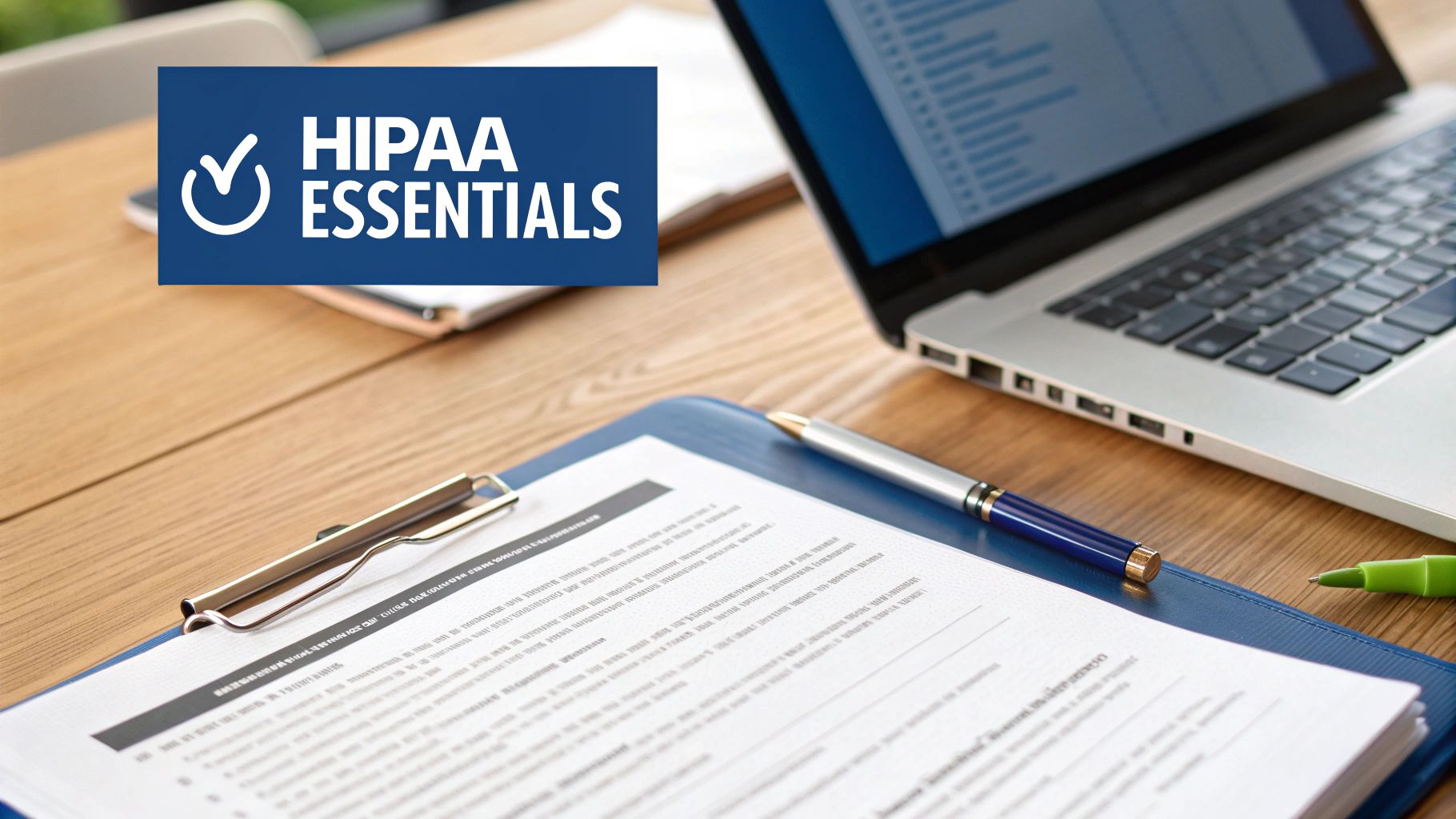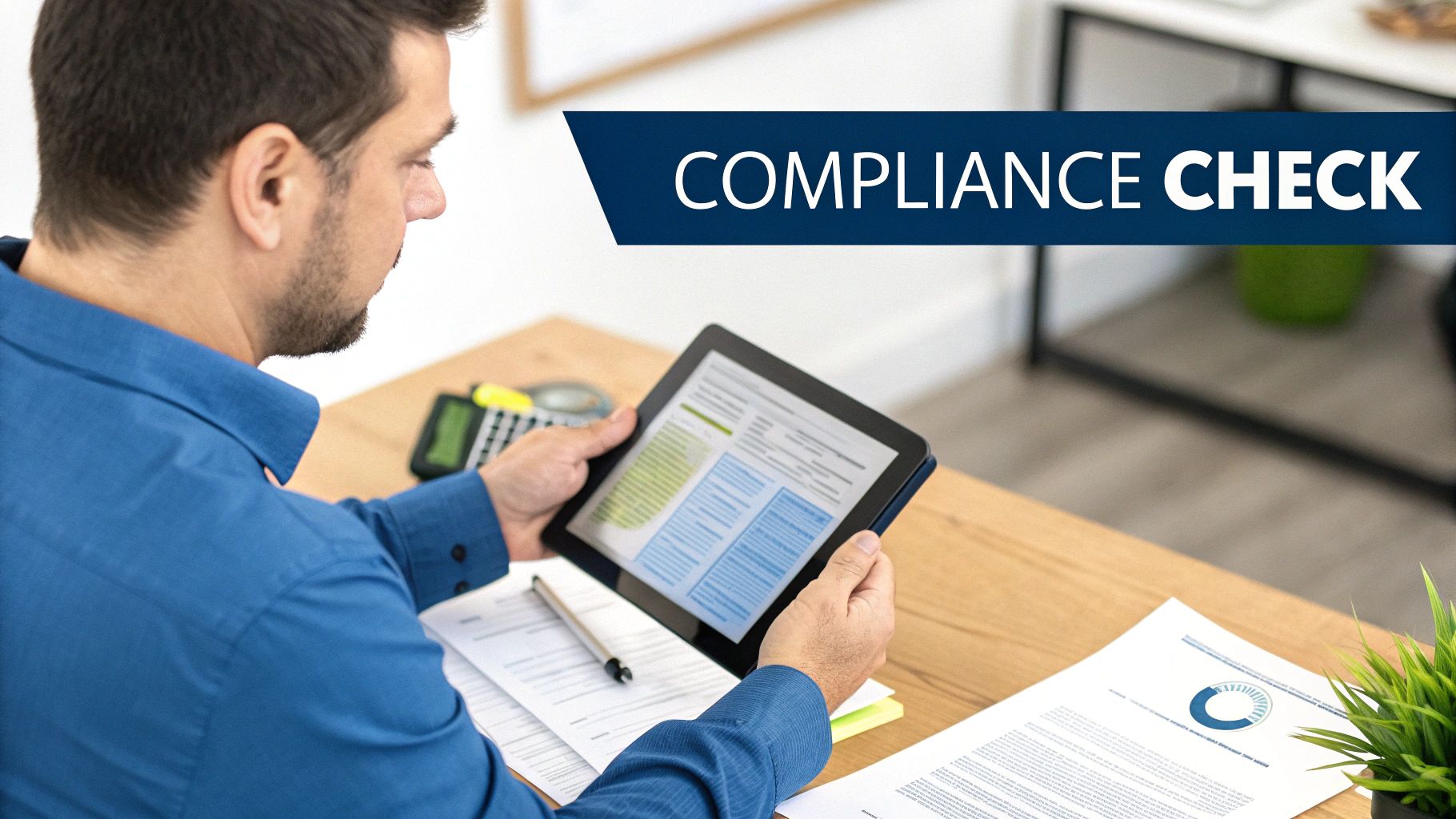HIPAA Compliance Requirements Checklist: A Complete Implementation Guide
Understanding HIPAA Compliance Fundamentals

The Health Insurance Portability and Accountability Act (HIPAA) sets strict standards for protecting patient health information. This section explains the key elements of HIPAA compliance that healthcare organizations need to know. At its core, HIPAA focuses on safeguarding Protected Health Information (PHI) through specific rules and requirements.
Key Components of HIPAA
HIPAA consists of four main rules:
- Privacy Rule: Controls how PHI can be used and shared. Gives patients specific rights over their health information, including requesting copies of records and limiting access. For example, patients can request their complete medical history or restrict certain providers from viewing their records.
- Security Rule: Protects electronic health records (ePHI) through required safeguards. Organizations must implement security measures like access controls, data encryption, and activity monitoring to keep electronic health data safe and accessible only to authorized users.
- Breach Notification Rule: Sets requirements for reporting data breaches involving PHI. Organizations must notify affected patients, the Department of Health and Human Services (HHS), and in some cases the media about breaches.
- Enforcement Rule: Outlines how HIPAA violations are investigated and penalized. Consequences range from monetary fines to criminal charges based on the violation type and severity.
The HIPAA Omnibus Rule of 2013 marked an important update to these regulations. It expanded patient rights and made third-party vendors (business associates) directly responsible for HIPAA compliance - a critical change as electronic health records became more common. Learn more about specific requirements at HIPAA compliance requirements.
Practical Approaches to HIPAA Compliance
Good HIPAA compliance requires careful planning and implementation. Many organizations create a HIPAA compliance requirements checklist that includes:
- Risk Assessments: Regular reviews to find and fix security weak points
- Policies and Procedures: Clear guidelines that follow HIPAA rules
- Training: Required education for all staff who handle patient information
- Incident Response Plan: Step-by-step procedures for handling security issues and breaches
Following these practical steps helps build strong HIPAA compliance programs that protect patient data effectively.
Mastering the HIPAA Risk Assessment Process
High-quality risk assessments form the foundation of effective HIPAA compliance. Without proper assessment, healthcare organizations cannot effectively protect sensitive patient data. This section outlines proven approaches that leading healthcare providers use to conduct meaningful risk assessments that strengthen their security programs.
Identifying and Evaluating Vulnerabilities
The first step is creating a detailed inventory of all Protected Health Information (PHI). Organizations need to map out exactly where PHI exists, how it moves through their systems, and who can access it. Common sources include electronic health records, physical documents, email communications, and messaging platforms.
Organizations then need to identify potential threats that could compromise this PHI data. These typically fall into three main categories: human risks like unauthorized access, natural disasters like floods, and technical issues like outdated systems. Each threat must be evaluated based on its likelihood and potential impact.
To maintain strong PHI protection, healthcare organizations should use HIPAA compliance checklists that outline required security standards. Regular risk assessments are a key requirement. These assessments should document all PHI data flows, identify threats, evaluate existing safeguards, and determine risk levels for potential breaches. Learn more at HIPAA Journal.
Implementing Security Measures and Documenting Findings
After identifying vulnerabilities, organizations must put appropriate security controls in place. This includes both technical protections like data encryption and access management, as well as administrative safeguards like security policies and staff training. The goal is to reduce breach risks to acceptable levels.
Detailed documentation is vital for compliance. Records should cover identified vulnerabilities, implemented security measures, and any remaining risks. This documentation helps organizations track their security program and demonstrate compliance during audits.
Balancing Compliance and Operations
Healthcare organizations must find practical ways to meet HIPAA requirements while maintaining efficient operations. For example, security controls should protect patient data without creating barriers that prevent providers from accessing important medical information when needed. Finding this balance requires ongoing assessment and adjustment. Regular reviews help ensure security measures stay current with new threats while supporting the organization's operational needs.
Implementing Privacy Rule Requirements That Work

Protecting patient information requires more than just checking boxes on a compliance list. Healthcare organizations need to create practical privacy practices that support their operations while maintaining strong privacy standards. Here's how successful organizations make it work.
Effective Privacy Policies in Action
Strong privacy policies must address real situations that healthcare staff encounter daily. Staff training is essential - everyone who handles patient information needs clear instruction on privacy procedures. Managing access to patient data across departments also requires careful planning.
Think of patient data access like a bank vault - while everyone works at the bank, not everyone needs vault access. Similarly, healthcare staff should only access patient information necessary for their specific roles. This focused approach helps maintain both privacy and security.
Balancing Security and Accessibility
Healthcare teams face a key challenge: they need quick access to patient information to provide care, but this access must be carefully controlled. Clear guidelines about who can access what information, and when, help maintain this balance.
One proven method is role-based access control, which gives staff access based on their job duties. For example, doctors and billing staff would have different levels of access to patient records. Regular checks ensure these permissions stay appropriate.
The HIPAA Privacy Rule requires using the Minimum Necessary Standard - limiting access to only what's needed for specific tasks. This includes setting up role-based permissions and checking them regularly. Organizations must also follow state rules about keeping medical records and maintain HIPAA documentation for six years.
Practical Approaches and Innovative Solutions
Healthcare organizations often find success by using practical solutions for common privacy challenges. For instance, many now use secure messaging systems for discussing patient information internally, rather than regular email. This reduces the risk of exposing private data.
Another helpful approach is removing identifying details from patient data used in research or analysis. This protects patient privacy while still allowing the information to be useful. By taking these practical steps, organizations can protect privacy without slowing down important healthcare work.
Building Robust Technical Safeguards and Security Measures

Strong technical security measures form the foundation of HIPAA compliance when handling electronic protected health information (ePHI). This section details the key safeguards and practices healthcare organizations need to protect sensitive patient data.
Essential Technical Safeguards
The HIPAA Security Rule specifies several critical technical requirements that healthcare organizations must implement to protect ePHI access, integrity and confidentiality:
- Access Controls: These act as security checkpoints, requiring unique user IDs and strong passwords. Two-factor authentication adds an extra layer of security by requiring a second verification step beyond just a password.
- Audit Controls: These monitor and record all system activity related to ePHI. By tracking who accesses what information and when, organizations can spot potential security issues and prove HIPAA compliance during audits.
- Integrity Controls: These prevent unauthorized changes to patient data. Tools like checksums verify that information remains unaltered, ensuring healthcare providers can trust the accuracy of records.
- Transmission Security: When sending ePHI across networks, proper encryption and secure protocols like HTTPS keep the data safe from interception. This is similar to using registered mail to protect sensitive documents.
Implementing Multi-Layer Protection
Good security requires multiple protective measures working together. Think of it like a house with locks on the doors, window alarms, and security cameras - each layer adds important protection:
- Data Encryption: Converting data into coded form makes it unreadable without the proper decryption key, both when stored and transmitted. This protects ePHI even if other security measures fail.
- Firewalls: These security tools filter network traffic, blocking unauthorized access attempts while allowing legitimate users through. They form a critical barrier between internal systems and external threats.
- Intrusion Detection: Specialized monitoring systems watch for suspicious network activity 24/7, alerting security teams to investigate potential breaches before damage occurs.
Maintaining System Security
Keeping systems secure requires constant attention and updates. Regular assessments help identify and fix new vulnerabilities before they can be exploited:
- Security Updates: Promptly installing software patches closes security holes that attackers could use to access systems. Skipping updates leaves known weaknesses exposed.
- Risk Assessments: Regular security evaluations help organizations stay ahead of emerging threats. Using a detailed HIPAA compliance requirements checklist ensures no important safeguards are overlooked.
With proper implementation of these technical controls, healthcare organizations can build reliable security that protects patient data while meeting HIPAA requirements. Visit Whisperit to learn how our platform helps streamline HIPAA documentation and compliance tracking.
Creating Effective Training and Documentation Programs

HIPAA compliance requires constant attention and ongoing effort, particularly when it comes to training staff and maintaining documentation. Companies that excel at HIPAA compliance build strong programs focused on protecting patient privacy and data security as part of their everyday operations.
Developing Engaging and Effective Training
Most healthcare workers view compliance training as a boring requirement to check off their list. Smart organizations are changing this by making training interactive and meaningful. Using real-world scenarios, case studies, and even game-like elements helps staff better understand and remember key HIPAA concepts.
Training should match each person's specific role and responsibilities. For example, doctors need different HIPAA training than front desk staff. When training directly relates to someone's daily work, they're more likely to see its importance and apply what they learn. This targeted approach reinforces that everyone plays a vital part in protecting patient information.
Practical Approaches to Documentation Management
Good documentation forms the foundation of HIPAA compliance. Organizations need a complete HIPAA compliance requirements checklist covering policies, procedures, risk assessments, and training materials. Using standardized templates and a central document system makes this much easier to manage.
A centralized system gives staff one place to find current HIPAA documents while tracking changes and controlling access. Beyond making compliance simpler day-to-day, this organized approach prepares you for audits by having all required records readily available.
Building a Culture of Privacy and Security
The most successful HIPAA programs create an environment where protecting patient information becomes automatic. This starts with leaders consistently emphasizing privacy's importance. Regular updates about HIPAA rules, best practices, and compliance consequences keep privacy and security top of mind.
Organizations should also make it easy and safe for staff to report potential HIPAA issues. When employees know they can raise concerns without negative consequences, they become active partners in maintaining compliance. This open feedback helps catch and fix problems early. Learn how Whisperit can help streamline your HIPAA documentation and compliance tracking.
Maintaining Long-Term Compliance Success
A strong HIPAA compliance program takes ongoing dedication and adaptation. As technology changes and new requirements emerge, organizations must continually evaluate and strengthen their compliance measures. Here are key strategies for long-term success.
Ongoing Monitoring and Regular Audits
Think of HIPAA compliance like maintaining a healthy lifestyle - it requires consistent attention and checkups. Regular monitoring of system access, data usage patterns, and security events helps catch issues early. Both internal and external audits provide valuable insights into compliance gaps. For example, reviewing user access permissions quarterly can identify inappropriate access rights before they lead to problems.
Effective Policy Updates and Adaptations
Your compliance policies must evolve alongside regulatory changes and new guidance. Set up a process to regularly review and update your HIPAA compliance documentation. This helps your organization stay current with requirements and industry best practices. When new guidelines come out, like updated encryption standards, promptly incorporate them into your procedures. Consider working with HIPAA experts and subscribing to regulatory updates to stay informed.
Building a Culture of Compliance
For HIPAA compliance to truly succeed long-term, it must become part of your organizational DNA. This means making security and privacy central to daily operations. Go beyond annual training sessions - reinforce HIPAA principles through regular team discussions, real-world examples, and ongoing education. Create an environment where staff feel comfortable reporting potential security issues. When compliance becomes second nature, maintaining it becomes much easier.
Strategic Approaches for Resource Constraints
Many organizations face the challenge of maintaining compliance with limited staff and budget. Focus efforts on highest-risk areas and look for ways to work efficiently. Use security tools to automate monitoring and reporting where possible. This frees up staff time for other critical compliance tasks. With smart prioritization and the right tools, even resource-constrained organizations can maintain strong compliance programs.
Make ongoing HIPAA compliance simpler with Whisperit. Our platform helps streamline documentation and tracking to keep your program on track. Visit Whisperit to learn more.